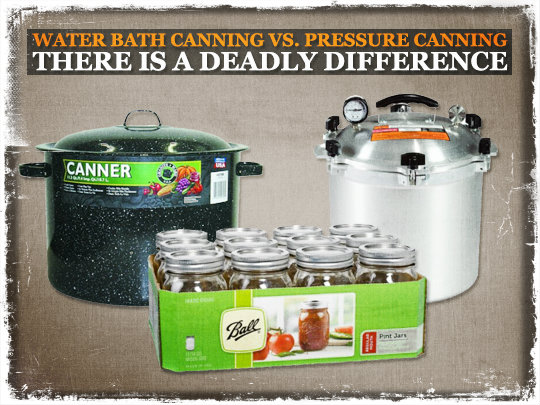
The botulinum bacteria if left to grow will produce spores and create a deadly toxin that can result in food borne botulism. The bacterium, “C. botulinum” is present in soil and in marine sediment. The spores can be found on many fruits and vegetables, but the spores are harmless at this stage, because to grow and to create toxins, they need a low oxygen, low acid environment.
The perfect low oxygen low acid environment would be in low acidic foods canned without sufficient heat to destroy the bacteria/spores. Hot water bath canning at 212° F removes the oxygen from the jars for example, but the heat is not adequate to destroy the bacteria thus, creating the perfect environment.
Temperatures between 240 and 250° F will destroy the bacteria that can cause botulism.
The bacterium cannot grow in foods when the pH level is below 4.6. Acidic foods, such as fruits, and most tomatoes and foods specifically pickled using vinegar can be canned in a boiling water bath canner. Food high in acid do not provide the proper environment for the spores to grow and thus can be canned using a boiling bath.
Meats are low in acid however, and so if canned without sufficient heat to kill the bacteria the toxin can develop. To kill the bacteria the water temperature must be between 240 and 250° F and the foods being canned must be maintained at these temperatures for a specific time. The times will be stated in the operator’s manual. The processing times will vary depending on number of jars, types of food, type of pressure canner in some cases, and elevation.
The only way to achieve the proper temperatures to destroy the bacteria is to use a pressure canner. Red meats, fish and poultry, and most vegetables, for example, must be processed under pressure for a specific time to destroy the spores.
As we stated earlier foods high in acid, which means their pH level is below 4.6 can be safely canned using a simple boiling water bath canner. Certain other foods unless the acidity level (a pH level below 4.6) is increased by adding lemon juice, citric acid, or vinegar must be processed using a pressure cooker.
Non acidic or foods low in acid include red meats, poultry, fish, and fresh vegetables with the exception of certain tomato varieties.
Now you know that all low-acid foods must be processed at temperatures between 240 and 250° F, which can only be done using a pressure canner usually operated at between 10 and 15 PSIG, which is Pounds Per Square Inch of Pressure.
All this is in your pressure cooker manual of course, and before getting started, you should read it thoroughly, so you understand the times and temperatures needed because the times can range from 20 to over 90 minutes depending on the food and elevation.
Temperatures of 240 F or above will be needed for reasonable process times and 10 psig equals 240 F at sea level, while 15 psig equals 250 F at sea level.
Your modern pressure canner today is lightweight and much easier and safer to use. Most are automated, so no more guess work and literally no danger. It is not the pressure that destroys the bacteria in foods however, but the heat which is only obtainable under pressure.
According to the USDA to be considered a pressure canner, the canner must be big enough to hold at least 4 quart-size jars. Pressure cookers with smaller volume capacities are not recommended for use in canning. Enough heat may not be delivered during pressurizing and the cool-down period in smaller pressure cookers/saucepans (USDA, n.d.).
What you will have to be careful with is when mixing foods that are to be canned such as soups. You may want to can vegetable beef soup for example, and while the recipe calls for tomatoes there would not be enough acid in the mixture to prevent bacteria growth if processed in a boiling water bath. You may add potatoes, corn, green beans and beef cubes which would need to be pressure canned at a higher heat than 212° F. The same thing would apply to any mixed food recipe.
You may want to can pasta sauces that contain meat and tomato or even cheese, but the sauce if it contains any vegetables or meat or food low in acid must be pressure canned. Remember you can, process virtually any food in a pressure canner safely, but there are many foods that cannot be safely canned in a boiling water bath.
Remember this and you cannot go wrong. Any recipes that you or someone else creates that combines high-acid foods like tomatoes, with low-acid foods, like vegetables or meats, are still considered low-acid foods and must be canned under pressure.
Some of the information may sound redundant to some people, but there are misconceptions out there about canning, which can cause sickness or worse.
There are nearly 145 cases of botulism reported each year in the United States and 15 percent of those cases are caused by eating foods that contain the bacteria.
Over 48 million people get sick each year in the United States from food borne diseases and bacteria. Out of those nearly 128,000 require hospitalization and out of those 3,000 die. Food not properly cooked, processed and handled is a growing problem. However, correct cooking times and temperatures and proper work area sanitation procedures would eliminate the vast majority of problems (CDC, n.d.).
CDC. (n.d.). Retrieved 2015, from http://www.cdc.gov/foodborneburden/
USDA. (n.d.). Retrieved 2015, from http://nchfp.uga.edu/publications/publications_usda.html